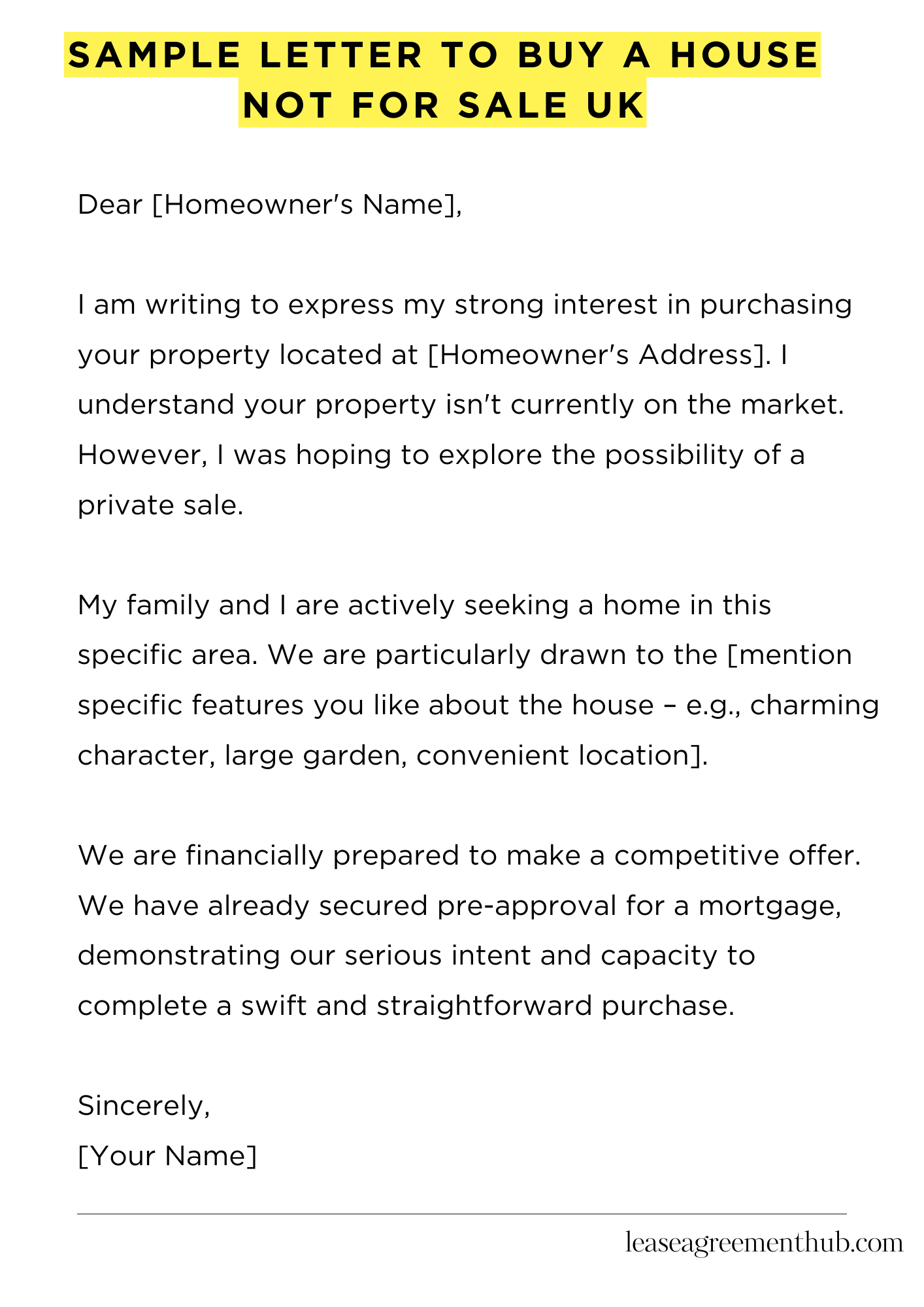Want to buy a house in the UK that’s not on the market? A letter to the homeowner is your first step. It’s your chance to make a compelling offer.
This article gives you example letters. These are templates. They’ll help you write your own letter. Use them as a starting point.
We provide various samples. They cover different situations. You can adapt them to your needs.
Sample Letter to Buy a House Not for Sale UK
[Your Name]
[Your Address]
[Your Phone Number]
[Your Email Address]
[Date]
[Homeowner’s Name]
[Homeowner’s Address]
Dear [Homeowner’s Name],
I am writing to express my strong interest in purchasing your property located at [Homeowner’s Address]. I understand your property isn’t currently on the market. However, I was hoping to explore the possibility of a private sale.
My family and I are actively seeking a home in this specific area. We are particularly drawn to the [mention specific features you like about the house – e.g., charming character, large garden, convenient location]. Your property perfectly fits our needs and preferences. It’s exactly what we’ve been searching for.
We are financially prepared to make a competitive offer. We have already secured pre-approval for a mortgage, demonstrating our serious intent and capacity to complete a swift and straightforward purchase. We are ready to proceed efficiently and smoothly.
I have attached a copy of my mortgage pre-approval letter for your review. This will confirm our financial standing and seriousness of purpose. It also provides evidence of our ability to proceed quickly. Please let me know if you might be open to considering a sale. I’d be happy to discuss this further at your convenience.
Thank you for your time and consideration. I look forward to hearing from you soon.
Sincerely,
[Your Name]

How to Write a Sample Letter to Buy a House Not For Sale UK
Understanding the Landscape: Initiating Contact
Purchasing a property in the UK that isn’t officially on the market requires a nuanced approach. Directly contacting the homeowner is paramount. Forget the reticence; a well-crafted letter is your ingress. This isn’t a mere enquiry; it’s a persuasive proposition.
Crafting Your Opening Salvo: The Art of the First Impression
Your initial paragraph must be compelling. Avoid generic platitudes. Begin with a specific, perhaps even serendipitous, detail about the property that demonstrates your genuine interest. Show, don’t tell. This reveals your meticulousness and elevates your proposition beyond a mere transactional request.
Articulating Your Offer: Presenting a Compelling Case
Clearly state your offer, including the price you’re willing to pay. Justify your valuation with succinct reasoning, referencing comparable properties or recent market trends. Provide proof of your financial capability – pre-approval from a mortgage lender significantly bolsters your credibility. Remember, brevity is key; avoid discursive elaboration.
Highlighting Your Strengths: More Than Just a Buyer
Position yourself as more than just a buyer; present yourself as an ideal homeowner. Highlight your stability, be it through employment history or financial assets. Emphasize any relevant experience in property ownership or maintenance. This mitigates the homeowner’s inherent risk aversion.
Addressing Potential Objections: Proactive Mitigation
Anticipate potential objections. Are they hesitant to sell? Address this directly. Perhaps their reluctance stems from emotional attachment; acknowledge this sentiment and offer reassurance. Consider framing your purchase as a win-win scenario, accentuating mutual benefits.
Maintaining Professionalism: The Etiquette of Persuasion
Maintain a professional and respectful tone throughout. Avoid undue pressure or aggressive tactics. Your letter should exude confidence without being overbearing. Proofread meticulously; grammatical errors undermine your credibility. A polished presentation is non-negotiable.
Concluding with Conviction: The Call to Action
Conclude with a clear call to action – requesting a response and suggesting a convenient timeframe for further communication. Provide your contact details in a readily accessible format. End with a courteous expression of gratitude for their time and consideration. Remember, you’re not demanding; you’re proposing a mutually advantageous transaction.
FAQs about sample letter to buy a house not for sale uk
Purchasing a property not currently on the market in the UK requires a strategic approach. A well-crafted letter can significantly increase your chances of success.
What information should I include in my letter to the homeowner?
Your letter should be polite and professional. Include your details (name, contact information), express genuine interest in the property, highlight your financial capabilities (pre-approval letter from a mortgage lender is highly recommended), and propose a fair purchase price. Mention your timeframe for purchase and express your understanding of their possible reluctance to sell.
How do I find the homeowner’s contact information?
You can try online searches, using the property address to find the owner’s details. Land Registry records might provide some information (though not always the current owner). You can also consider using a property search agent. Remember to respect the homeowner’s privacy and avoid intrusive tactics.
What is a suitable tone for this type of letter?
Maintain a respectful, persuasive, and confident tone throughout. Avoid being overly demanding or presumptuous. Focus on expressing your sincere interest and emphasizing the benefits of selling to you (e.g., a quick and uncomplicated sale). Proofread carefully for any grammatical errors or typos.
Should I mention a specific offer price in my initial letter?
While stating a specific price demonstrates seriousness, it might be wise to initially mention your budget range first. This allows for flexibility in negotiations and can avoid prematurely dismissing your interest. However, you should be prepared to make a concrete offer following an initial positive response.
What if the homeowner doesn’t respond to my letter?
A lack of response is common. You could try sending a follow-up letter or contacting the homeowner by phone (if you have their number) after a reasonable period (e.g., two weeks). If there’s still no response, respect their decision and move on to other potential properties.
Related: